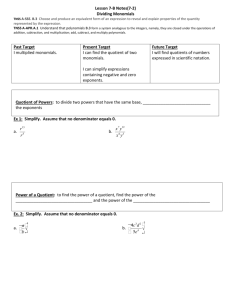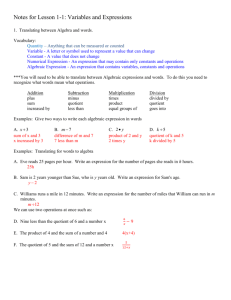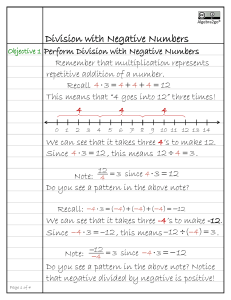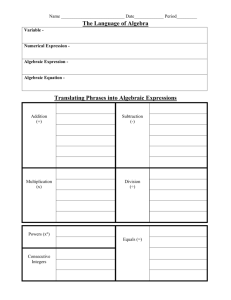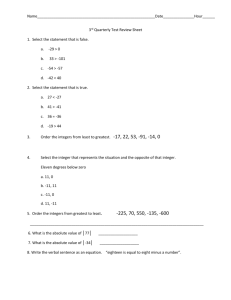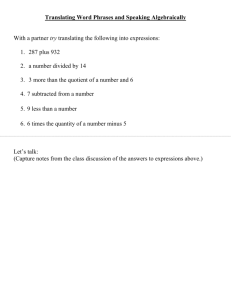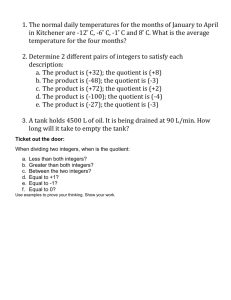Surface cyclic quotient singularities and Hirzebruch–Jung resolutions
advertisement
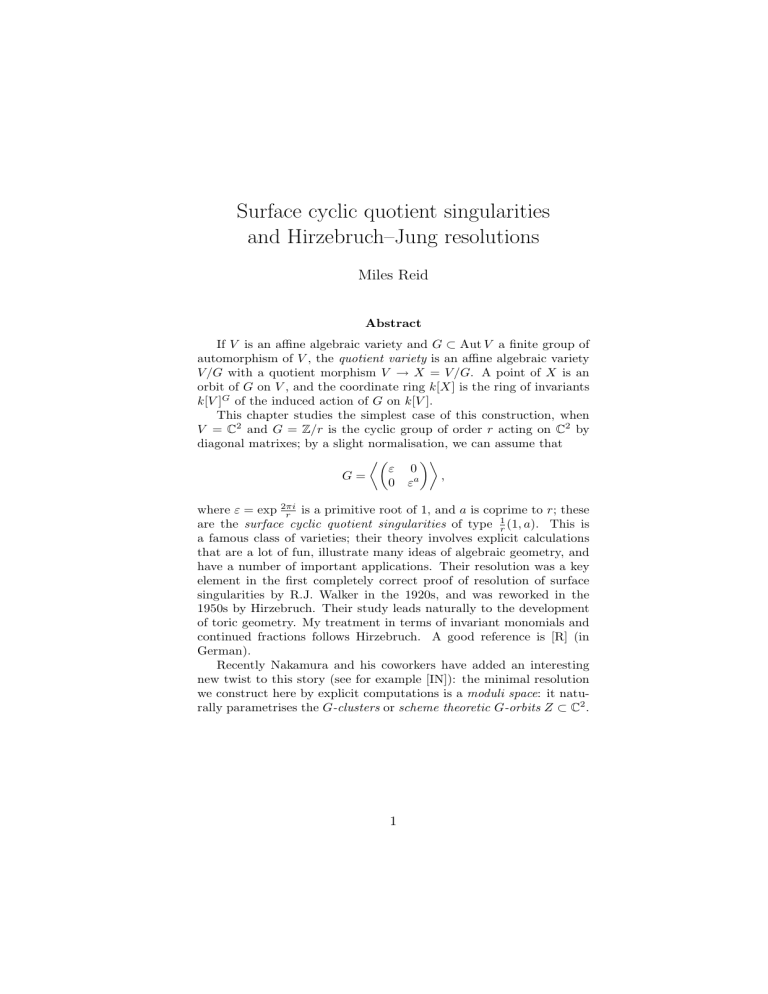
Surface cyclic quotient singularities
and Hirzebruch–Jung resolutions
Miles Reid
Abstract
If V is an affine algebraic variety and G ⊂ Aut V a finite group of
automorphism of V , the quotient variety is an affine algebraic variety
V /G with a quotient morphism V → X = V /G. A point of X is an
orbit of G on V , and the coordinate ring k[X] is the ring of invariants
k[V ]G of the induced action of G on k[V ].
This chapter studies the simplest case of this construction, when
V = C2 and G = Z/r is the cyclic group of order r acting on C2 by
diagonal matrixes; by a slight normalisation, we can assume that
ε 0
G=
,
0 εa
where ε = exp 2πi
r is a primitive root of 1, and a is coprime to r; these
are the surface cyclic quotient singularities of type 1r (1, a). This is
a famous class of varieties; their theory involves explicit calculations
that are a lot of fun, illustrate many ideas of algebraic geometry, and
have a number of important applications. Their resolution was a key
element in the first completely correct proof of resolution of surface
singularities by R.J. Walker in the 1920s, and was reworked in the
1950s by Hirzebruch. Their study leads naturally to the development
of toric geometry. My treatment in terms of invariant monomials and
continued fractions follows Hirzebruch. A good reference is [R] (in
German).
Recently Nakamura and his coworkers have added an interesting
new twist to this story (see for example [IN]): the minimal resolution
we construct here by explicit computations is a moduli space: it naturally parametrises the G-clusters or scheme theoretic G-orbits Z ⊂ C2 .
1
1
1.1
Introduction
Definition of quotient
We use the following standard result, whose proof is an exercise in commutative algebra (compare Mumford [M], Section 7 or Exs 4.3–4.4 for details).
The statement is intuitive, and you may take it on trust for now.
Proposition–Definition 1.1 G is a finite group acting on an affine variety
V by algebraic automorphisms. Write k[V ] for the coordinate ring of V .
Then the quotient X = V /G is an affine variety whose points correspond
one-to-one with orbits of the group action, and such that the polynomial
functions on X are precisely the invariant polynomial functions on V , that
is, k[X] = k[V ]G .
The quotient X as just defined exists: just take X = Spec k[V ]G . In
other words, we know that the ring k[V ]G is generated by finitely many
polynomials (an application of finiteness of normalisation, etc.). Write
k[V ]G = k[u1 , . . . , uN ]/J, where ui are the generators and J the ideal of
relations between them. Then V /G is the subvariety of affine space AN
k
(with coordinates u1 , . . . , uN ) defined by the ideal J:
X = V (J) = u ∈ k N f (u) = 0 for all f ∈ J ⊂ k N .
Example 1.2 The baby case 21 (1, 1). The simplest example is the group
action
Z/2 acting on C2 by (x, y) 7→ (−x, −y).
The monomials x2 , xy, y 2 are obviously invariant under the Z/2 action, and
it is not hard to see that any Z/2-invariant polynomial in x, y (that is, any
even polynomial) is a polynomial in these. Consider the polynomial map
ϕ : C2 → X ⊂ C3
defined by (x, y) 7→ (u = x2 , v = xy, w = y 2 ),
where u, v, w are coordinates on C3 ; its image X is the ordinary quadratic
cone X : (uw = v 2 ). Then X = C2 /(Z/2) is an example of a quotient by a
group action.
I explain what resolution of singularities means in this simple context.
Write C for the base of the cone X : (uw = v 2 ), so that C is the standard
conic in P2C , defined by the same equation viewed as the homogeneous equation U W = V 2 . It is well known and easy that C is isomorphic to P1 (see
[UAG], §1).
2
Figure 1: The cylinder resolution of the quadratic cone X : (uw = v 2 )
Quite generally, a cone X over a nonsingular base variety C has a resolution of singularities given by the corresponding cylinder; whereas X is the
union of generating lines through the vertex O, the cylinder is the C1 -bundle
obtained as the disjoint union of these generating lines. For Q ∈ C, write
LQ ∼
= C for the generator of the cone through Q, and set
Y = P ∈ X, Q ∈ C P ∈ LQ ⊂ X × C.
In other words, Y is the closed graph of the projection of the cone to its
base. The projection Y → C is the cylinder over C corresponding to the
cone X; that is, it is the C1 -bundle obtained as the disjoint union of the
generating lines LQ of X. The second projection f : Y → X is the resolution
of singularities of X: this means
(a) Y is nonsingular.
(b) f : Y → X is a projective birational morphism; in particular, f is
surjective, and f −1 (0) is projective.
(c) Y → X an isomorphism Y \ f −1 (0) → X \ 0.
To see Y in coordinates, I cover C by two copies of the affine line: the
piece C0 : (W 6= 0) is parametrised by ξ 2 , ξ, 1, and the piece C1 : (U 6= 0)
by 1, η, η 2 (where ξ = x/y = u/v and η = y/x = w/v). Glueing together
these copies of C1 by ξ = η −1 (on the open set U W 6= 0) makes explicit the
identification C ∼
= P1 .
The cylinder Y is also covered by two affine pieces: since it is a C1 -bundle
over C, each piece is ∼
= C2 , with a coordinate in the base C, and a coordinate
in the fibre: this gives Y = Y0 ∪ Y1 where Y0 = C2 with coordinates (ξ, w)
and Y1 = C2 with coordinates (η, u). The glueing between the two pieces
where they overlap is given by
∼
=
Y0 \ (ξ = 0) −→ Y1 \ (η = 0) by
(ξ, w) 7→ (η = ξ −1 , u = wξ 2 ).
Here ξ and η are parameters on the base C ∼
= P1 , and u, w linear coordinates
2
in the fibre. The identification u = wξ is the transition function of a C1 bundle: either u or w can be used as the linear coordinate in the fibre, but
the coordinate change between them depends on ξ.
3
1.2
Notation and aim
The notation 1r (1, a) stands for the action of the cyclic group Z/r on C2
given by (x, y) 7→ (εx, εa y), where ε = exp( 2πi
r ) is a chosen primitive rth
root of unity. The aim of this chapter is to treat the quotient singularities
X = C2 /(Z/r) by analogy with the case 12 (1, 1) discussed above. I explain
(1) what it means to give this quotient the structure of an affine algebraic
variety,
(2) how to describe its coordinate ring in terms of monomial generators
and relations, and
(3) how to construct a resolution of singularities Y → X.
All of this involves very concrete numerical calculations starting from the
numbers r, a.
1.3
More examples
I can generalise the baby example in several different directions:
1.
1
r (1, 1);
the quotient is isomorphic to the affine cone over the rational
normal curve Cr ⊂ Pr , and its resolution has exceptional locus E ∼
= Pr
2
with E = −r.
2. Every finite cyclic subgroup G ⊂ SL(2, C) is of the form 1r (1, r − 1);
the quotient is the hypersurface singularity uw = v r .
3. The general case 1r (1, a) with a coprime to r. There are automatic
and very convenient descriptions of the quotient and its resolution in
terms of Hirzebruch–Jung continued fractions; this is the main point
of this chapter. Moreover, the resolution equals the Hilbert scheme of
G-orbits.
4. Non-Abelian finite subgroups G ⊂ SL(2, C); these are classified as the
binary dihedral, binary tetrahedral, binary octahedral and binary dihedral groups, and correspond to the Du Val singularities Dn , E6 , E7 , E8 .
Work of Ito and Nakamura [IN] shows that in these cases also, the minimal resolution equals the Hilbert scheme of G-orbits.
5. Non-Abelian finite subgroups G ⊂ GL(2, C); these are classified in
A, D, E terms, and the resolutions are known. At the present time,
whether the minimal resolution equals the Hilbert scheme of G-orbits
is an interesting open question.
4
2
Hirzebruch–Jung continued fractions and the
Newton polygon of the lattice L = Z2 + Z · 1r (1, b)
To treat more general cases, we need some more notation and some fairly
easy combinatorics.
Definition 2.1 Let r, b be coprime integers with r > b > 0. Then the
Hirzebruch–Jung continued fraction of r/b is the expression
r
1
= a1 −
= [a1 , a2 , . . . , ak ].
1
b
a2 − a3 −···
(2.1)
For example,
7
1
= [3, 2, 2] = 3 −
3
2−
1
2
.
Here 3 = 73 is the roundup (the least integer ≥ a fraction). The overshoot
is 3− 73 = 23 , and we take its reciprocal to get 32 = 2− 12 . See the homework
sheet for more examples.
In general, (2.1) means the following: if r and b are given, write a1 = rb
for the roundup; a1 ≥ 2 because r > b. If b = 1 then r = r/b = [a1 ] is an
integer, so we stop. Failing that, there is a fractional overshoot of a1 − rb , and
we take its reciprocal ba1b−r = rb11 as a new fraction (still with r1 > b1 > 0
and coprime), and calculate rb11 = [a2 , . . . , ak ] recursively. In other words,
replace
r
r1
r1
0
1
r
b
7→
where
=
=
(2.2)
b1
−1 a1
b
ba1 − r
b
b1
and continue likewise.
Conversely, if [a1 , . . . , ak ] are given with each ai ≥ 2, then we calculate
from the other end: set [ak ] = ak , and for i = k, k − 1, . . . , 2
[ai−1 , . . . , ak ] = ai−1 −
1
[ai , ai+1 , . . . , ak ]
See the homework sheet for an interpretation of [a1 , . . . , ak ] in terms of
0
1
0
1
0
1
...
−1 a1
−1 a2
−1 ak
the product of elementary matrixes in SL(2, Z). You can view this as the
composite of k changes of bases from e0 , e1 to e1 , e2 , etc. to ek , ek+1 .
5
Proposition 2.2 Let r > b > 1 be coprime integers and consider the lattice
L = Z2 + Z · 1r (1, b) ⊂ R2 . Then L contains the lattice Z2 as a sublattice
of index r, and its other cosets are represented by the r − 1 lattice points
1
2
r (i, ib) contained in the unit square of R (see Figure 2). Define the Newton
t(0, 1)
r
r
t
t(0, 0)
r
r
te0 = (0, 1)
C
C
C e1 = 1r (1, b)
CtH
Ht
HHtek
H
t
Ht
r
r
(0, 0)
t
(1, 0)
(0, 0)
ek+1 = (1, 0)
Figure 2: The lattice L and its Newton polygon
polygon as the convex hull Newton L in R2 of all the nonzero lattice points
in the positive quadrant.
Write
e0 = (0, 1),
1
e1 = (1, b),
r
e2 , . . . , ek ,
ek+1 = (1, 0)
for the lattice points on the boundary of Newton L.
Then
(I) Any two consecutive lattice points ei , ei+1 for i = 0, . . . , k form an
oriented basis of L.
(II) Any three consecutive lattice points ei−1 , ei , ei+1 for i = 1, . . . , k satisfy
a relation
for some integer ai ≥ 2.
ei+1 + ei−1 = ai ei
(III) The integers a1 , . . . , ak in (II) are the entries of the continued fraction:
r
= [a1 , . . . , ak ].
b
The relation in (II) can be viewed as a coordinate change
from the basis
0 1
ei−1 , ei to the next basis ei , ei+1 expressed by the matrix
, that is,
−1 ai
ei = (0, 1) = ei ,
ei+1 = (−1, ai ) = −ei−1 + ai ei .
6
Proof (I) Consider the parallelogram Π = h0, ei , ei+1 , ei + ei+1 i; by construction of Newton L, the lower triangle ∆ = h0, ei , ei+1 i has no lattice
point other than its vertices. For any point v in the upper triangle ∆+ =
hei , ei+1 , ei + ei+1 i, the point ei + ei+1 − v is in the lower triangle ∆ =
h0, ei , ei+1 i; thus the upper triangle also has no lattice points other than its
vertices. The conclusion is that Π has no lattice points other than its vertices. It follows that Π is a fundamental domain for L acting by translation
on R, and therefore ei , ei+1 is a basis of L.
Remark 2.3 Thus for plane lattices, the convexity condition is very strong,
and implies that we get a Z basis of a lattice. This part of the argument
fails in dimension ≥ 3.
(II) Since ei−1 , ei is a basis, I can certainly write ei+1 = αei−1 + βei
with α, β ∈ Z. On the other hand, for ei , ei+1 to be a basis, ei−1 must be
expressed as an integral linear combination of them, and therefore α = ±1.
But from the figure, ei is a positive combination of ei−1 and ei+1 so that
α = −1 and the relation is ei−1 + ei+1 = βei with β > 0; if β = 1 then ei is
in the interior of Newton L, so β ≥ 2. This proves (II).
(III) We have e0 +e2 = a1 e1 where a1 is as in (II). Thus e2 = 1r (a1 , a1 b−r)
is in the unit square. Therefore a1 b − r ≥ 0; moreover, a1 b − r ≥ b is
impossible, since then e2 would be above e1 , contradicting the construction
of e2 as a point on the boundary of Newton L. Therefore a1 = rb .
The argument for a2 , . . . , ak works recursively: write
L = (Z · e1 ⊕ Z · ek+1 ) + Z · e2 .
If I take a new copy of Z2 with basis e1 , ek+1 (not e0 , ek+1 ) then since e2 =
1
1
2
b (e1 + (a1 b − r)ek+1 ), I have L = Z + Z r1 (1, b1 ), where r1 , b1 are as in (2.2).
The Newton polygon of L in the smaller cone spanned by e1 , ek+1 is the
same as before,
l mso that by the preceding argument, I have e1 + e3 = a2 e2
where a2 = rb11 . The result follows by recursion. Q.E.D.
Example 2.4 Figure 2 illustrates Z2 + Z · 17 (1, 3). The Newton boundary
points are
e0 = (0, 1),
1
e1 = (1, 3),
7
1
e2 = (3, 2),
7
1
e3 = (5, 1),
7
e4 = (1, 0)
We have 37 = [3, 2, 2]; then e0 + e2 = 3e1 , which in the figure means that the
Newton boundary is strictly convex at e1 . The coefficients 2 at e2 , e3 reflect
the fact that the boundary is a straight line.
7
Corollary 2.5 As in 1.2, write 1r (1, a) for the action of Z/r on C2 by
(x, y) 7→ (εx, εa y). Then the invariant monomials of the action are generated by
u0 = xr ,
u1 = xr−a y,
u2 , . . . , u k ,
uk+1 = y r ;
these satisfy
ui−1 ui+1 = uai i
for i = 1, . . . , k,
(2.3)
r
where the exponents ai are the entries of r−a
= [a1 , . . . , ak ].
Note that this calculates the ring of invariant monomials C[x, y]G for us:
it is generated by the monomials ui , and the relations (2.3) (while only a
subset of all the relations) are already enough to specify all the ui as rational
expressions in u0 , u1 , or in any two consecutive monomials ui , ui+1 .
Thus the morphism C2 → X ⊂ Ck+2 is the quotient of PropositionDefinition 1.1. The relations (2.3) determine the image X set-theoretically;
for a full set of generators of the ideal I(X) we also need relations for ui uj
with |i − j| ≥ 2.
Since the group acts on xα y β by εα+bβ , the invariant monomials are xα y β
where α + bβ ≡ 0 mod r. The exponents form the lattice
M = Z2 h(r, 0), (0, r)i + Z · (r − a, 1),
to which Proposition 2.2 applies.
Example 2.6 The calculation comes out in a nice uniform way in two important cases. The first is 1r (1, 1), in which the invariant monomials are
u0 = xr , u1 = xr−1 y, . . . , ui = xr−i y i , . . . , ur+1 = y r . The relations holding
between these are
u0 u1 . . . ur−1
rank
≤ 1.
u1 u2 . . .
ur
r
In particular, all the ai = 2, giving r−1
= [2, 2, . . . , 2] with r − 1 repetitions
of 2.
The other case is 1r (1, r−1). Then the invariant monomials are generated
by u = xr , v = xy, w = y r , with the single relation uw = v r . The continued
fraction is 1r = [r].
8
3
Resolution of singularities
Example 3.1 I now discuss the case 1r (1, 1) and its resolution, which is
very similar to the quadratic cone of Example 1.2. Here the cyclic group
Z/r acts on C2 by (x, y) 7→ (εx, εy). All the monomials of degree r in x, y
are invariant: write
ui = xr−i y i
for i = 0, . . . , r.
It is easy to see that the ui generate k[x, y]Z/r , with relations
u0 u1 . . . ur−1
rank
≤1
u1 u2 . . .
ur
(3.1)
(3.2)
(that is, ui uj+1 = ui+1 uj for 0 ≤ i < j ≤ r − 1. This is true because
ui−1
x
=
ui
y
for i = 1, . . . r.
Write X ⊂ Cr+1 for the variety defined by these equations. This is a cone
over the rational normal curve P1 ∼
= Cr ⊂ Pr . Here I’m more interested in
its resolution. Compare Example 1.2.
One sees from (3.2) that outside the origin, one of u0 or ur 6= 0, so that
the ratio between the two rows of the matrix in (3.2) is well defined as a
point of P1 ; this ratio is just x : y. Introducing this ratio as a new function
tells us exactly how to resolve the singularity of X. In fact η = u1 /u0 = y/x
is a regular function at any point where u0 6= 0 and (3.2) gives
ui = u0 η i
for i = 0, . . . , r.
so that X is parametrised by u0 = xr and η = u1 /u0 = y/x.
More precisely, write Y0 for a copy of C2 with coordinates ξ, w, where
ξ = x/y. Then
σ0 : (ξ, w) 7→ (u0 = ξ r w, u1 = ξ r−1 w, . . . , ur = w),
(3.3)
defines a morphism σ0 : Y0 → X that restricts to an isomorphism
∼
=
Y0 \ {ξ-axis} −→ X \ {u0 -axis},
and contracts the ξ-axis w = 0 to the origin (0, . . . , 0) ∈ X. The inverse
rational map is given by
w = ur ,
ξ=
u0
ur−1
= ··· =
.
ur
u1
9
The “cylinder” resolution of X is Y = Y0 ∪ Y1 , where Y0 = C2 with
coordinates (ξ, w) and Y1 = C2 with coordinates (η, u). The glueing between
the two pieces where they overlap is given by
∼
=
Y0 \ (ξ = 0) −→ Y1 \ (η = 0) by
(ξ, w) 7→ (η = ξ −1 , u = wξ r ).
(3.4)
The morphism σ : Y → X is given by (3.3) on Y0 and something similar on
Y1 .
It is clear from (3.4) that Y has a morphism p : Y → P1 , defined by (ξ : 1)
on Y0 and (1 : η) on Y1 , and that it is a C1 bundle over P1 . The exceptional
locus of the morphism p : Y → X is the zero section of the bundle p, defined
by u = w = 0. The twisting of the C1 bundle is given by the transition
function ξ r in (3.4).
Theorem 3.2 As usual, consider the action of Z/r on C2 of type 1r (1, a)
and the cyclic quotient singularity X = C2 /(Z/r) of Corollary 2.5. Write L
for the overlattice L = Z2 + Z · 1r (1, a) of Z2 , and
M = (α, β) α + aβ ≡ 0 mod r ⊂ Z2
for the dual lattice of invariant monomials.
Write ar = [b1 , . . . , bl ], and let e0 , e1 , . . . , ek+1 be as in Figure 2 of Proposition 2.2. For each i = 0, . . . , k, let ξi , ηi be monomials forming the dual
basis of M to ei , ei+1 ; that is, such that
ei (ξi ) = 1, ei (ηi ) = 0,
ei+1 (ξi ) = 0, ei+1 (ηi ) = 1.
Then X has a resolution of singularities Y → X constructed as follows:
Y = Y0 ∪ Y1 ∪ · · · ∪ Yl ,
(3.5)
where each Yi ∼
= C2 with coordinates ξi , ηi .
The glueing Yi ∪ Yi+1 in (3.5) and the morphism Y → X are both determined automatically by the definition of ξi , ηi consists of
∼
=
Yi \ (ηi = 0) −→ Yi \ (ξi+1 = 0)
defined by
ξi+1 = ηi−1 , ηi+1 = ξi ηibi .
r
Remark 3.3 Don’t confuse the continued fraction of r−a
used for the calculation of invariant monomials in Corollary 2.5 with that of ar in Theorem 3.2. The first refers to the Newton polygon of the sublattice M of
invariant monomials, whereas the second refers to the dual overlattice L.
10
Example 3.4 Consider 17 (1, 4). By Corollary 2.5,
invariant monomials are generated by
7
7−4
= [3, 2, 2] and the
u0 = x7 , u1 = x3 y, u2 = x2 y 3 , u3 = xy 5 , u4 y 7
(3.6)
with u31 = u0 u2 , etc. This provides the ring of invariants k[x, y]Z/r and the
definition of the quotient variety X.
The resolution of singularities is given by 47 = [2, 4] and the consecutive
lattice points on the Newton boundary of L = Z2 + Z · 74 ; these are
1
1
e0 = (0, 1), e1 = (1, 4), e2 = (2, 1), e3 = (1, 0).
7
7
Taking dual bases gives
ξ0 = x7 , η0 = y/x4 ,
ξ1 = x4 /y, η1 = y 2 /x,
ξ2 = x/y 2 , η2 = y 7 .
Thus Y = Y0 ∪ Y1 ∪ Y2 , with 3 copies of C2 glued by
ξ1 = η0−1 , η1 = ξ0 η02 ,
4
ξ2 = η1−1 , η2 = ξ1 η14 .
Exercises
Exercise 4.1 Check all the assertions in 1.2 concerning the quotient 21 (1, 1).
(Compare [Ch], Chapter 4, 4.1.)
Exercise 4.2 In the exercise 71 (1, 4), verify that the fibres of the quotient
morphism C2 → C5 (defined by u0 , . . . , u4 in (3.6)) are exactly the group
orbits.
Exercise 4.3 Prove k[V ]G is f.g.
Exercise 4.4 Verify that the morphism π : V → X = V /G constructed in
Proposition–Definition 1.1 is
1. well defined;
2. injective;
3. surjective.
11
Thus π is a set theoretic 1-to-1 correspondence from the orbits of G on V to
the points of X (as stated implicity in (1.1)). [Hint: π well defined is clear.
For injective, write Ox = G · x for the orbit; if Ox ∩ Oy = ∅ then use the
NSS to deduce the existence of a polynomial that is zero on Ox and nonzero
at a point of Oy ; a suitable combination of these, f say, is nonzero at every
point of Oy . Now take a product g ∗ f over g ∈ G to obtain a G-invariant
function on X separating Ox and Oy . For surjective, use the fact that the
extension k[V ]G ⊂ k[V ] is finite, plus generalities on finite maps (see e.g.,
[UCA], Chapter 4.]
Exercise 4.5 In Example 3.1, prove that the ui generate k[x, y]Z/r ; also,
every relation between the monomials is in the ideal generated by (3.1)
[Hint: This is combinatorics with monomials. Generators: the only invariant
monomial of degree < n is 1; any monomial of degree ≥ n is divisible by one
or more of the ui . Relations: the monomials of degree d ≥ 1 in u0 , . . . , ur
correspond (many-to-one) to monomials of degree nd in x, y; choose a subset
that correspond one-to-one (for example, the first monomial in the ui in lex
ordering corresponding to xnd−i y i ). Then the relations (3.1) can be used to
translate any monomial of degree d ≥ 1 in u0 , . . . , ur into one of the chosen
set.]
Exercise 4.6 For the quotient singularity 1r (1, r − 1) of Example 2.6, show
how to write down explicitly r affine pieces Yi ∼
= C2 and glueing maps
S
(0)
(0)
Yi ∼
= Yj between their dense open pieces so that Y = Yi is a resolution
of X : uw = v r ⊂ C3 . [Hint: Yi := C2 with coordinates λi , µi where
λi = xn−i /y i and µi = y i+1 /xn−i−1 .]
Exercise 4.7 For the group action 1r (1, r − 1) of Example 2.6, show that
every G-cluster Z ⊂ C2 is defined by
xn−i = λi y i ,
y i+1 = µi xn−i−1 ,
xy = λi µi
for some i and some λi , µi .
References
[CR] Alastair Craw and M. Reid, How to calculate A-Hilb C3 , in Ecole
d’été sur les variétés toriques (Grenoble, 2000), collection Séminaires
et Congrès, SMF 2001, to appear; preprint 32 pp., math.AG/9909085
12
[H]
F. Hirzebruch, Über vierdimensionale Riemannsche Flächen mehrdeutiger analytischer Funktionen von zwei komplexen Veränderlichen,
Math. Ann. 126 (1953) 1–22
[IN] ITO Yukari and NAKAMURA Iku, Hilbert schemes and simple singularities, in New trends in algebraic geometry (Warwick, 1996), CUP,
1999, pp. 151–233
[J]
H.W.E. Jung, Darstellung der Funktionen eines algebraischen Körpers
zweier unabhängigen Veränderlichen x, y in der Umbegung einer Stelle
x = a, y = b, J. reine angew. Math. 133 (1908) 289–314
[M]
D. Mumford, Abelian varieties, OUP, 1974
[UAG] M. Reid, Undergraduate algebraic geometry, CUP, 1988
[UCA] M. Reid, Undergraduate commutative algebra, CUP, 1995
[Ch] M. Reid, Chapters on algebraic surfaces, in Complex algebraic varieties, J. Kollár (Ed.), IAS/Park City lecture notes series (1993 volume), AMS, pp. 1–154
[R]
Oswald Riemenschneider, Deformationen von Quotientensingularitäten (nach zyklischen Gruppen), Math. Ann. 209 (1974) 211–248
13
5
Orbifold Hilbert schemes and resolution of toric
singularities
Ito and Nakamura introduced the notion of orbifold Hilbert scheme of a
quotient by a group orbit, and used it to provide a construction of the
minimal resolution Y → X of the Gorenstein surface quotient singularities
X = C2 /G for any finite subgroup G ⊂ SL(2, Z), related to the GonzalezSprinberg–Verdier form of the McKay correspondence. This paper extends
the definition of orbifold Hilbert scheme to any1 toric variety X in terms of
the algebra of Weil divisor classes, and shows that it provides a distinguished
toric resolution of singularities Y → X (not necessarily minimal).
I learn how to calculate the Ito–Nakamura Hilbert scheme for certain
classes of Abelian quotient singularities. I prove in particular that it provides the minimal resolution of the Hirzebruch–Jung cyclic quotient singularities 1r (1, a) and a distinguished choice of crepant resolutions for Gorenstein
3-fold Abelian quotient singularities (despite the apparently widespread belief among 3-folders that this is impossible because of flops).
5.1
First definitions
I start by reproducing the definition of Ito and Nakamura in a convenient
form.
Definition 5.1 G acts linearly on Cn . An IN ideal is an ideal J ⊂ OCn
with the two properties:
1. J is invariant under G;
2. the quotient OCn /J is the regular representation of G (that is, isomorphic to k[G] as G-module); in particular, J ⊂ OCn has colength
N = card G.
Equivalently, I can take J ⊂ k[Cn ] = k[x1 , ..xn ] (more commonly k[x, y],
k[x, y, z], etc.).
I assume from now on that G is an Abelian group acting diagonally (it is
of course an exceedingly interesting problem to generalise this assumption).
Write π : Cn → X = Cn /G for the quotient map; then OX = π∗ OCGn is the
sheaf of invariants of G in OCn .
1
This is based on an old version, and “any” is certainly exaggerated
14
Write G∨ = Hom(G, C× ) for the character group; a character a ∈ G∨
is a function a(g) on G with values in the roots of unity, and such that
a(g1 g2 ) = a(g1 )a(g2 ). It corresponds to a divisorial sheaf OX (a) on X,
consisting of functions on Cn that are eigenfunctions of the action of each
g ∈ G with eigenvalue a(g):
OX (a) = f ∈ π∗ OCn g ∗ (f ) = a(g)f };
this is the eigensheaf corresponding to a. Although sections of OX (a) are
not themselves functions on X, the ratio of any two nonzero sections of
OX (a) can be viewed as a rational function on X (just as ratios fd /gd of
forms of the same degree are rational functions on projective space). It is
well known that the sheaves OX (a) for a ∈ G∨ correspond one-to-one to
divisorial sheaves on X up to isomorphism, so that
G∨ = Cl X,
where Cl X is the group of Weil divisor classes. An element g ∈ G is a
quasireflection (sometimes unitary reflection) if it fixes pointwise a hyperplane Cn−1 ⊂ Cn , or in other words, g is conjugate to diag(ε, 1, . . . , 1). I
assume here, without too much loss of generality, that G has no quasireflections.
Now attend carefully to Condition 2 in Definition 5.1. Because an INideal J is G-invariant, the exact sequence
0 → J ⊂ π∗ OCn → O/J → 0
splits up as a direct sum of sequences
0 → J(a) ⊂ OX (a) → (O/J)(a) → 0
for a ∈ G∨ ;
Condition 2 says that each quotient OX (a)/J(a) is isomorphic to the eigenspace k[G]a ⊂ k[G], so is one dimensional. This proves the following proposition:
Proposition 5.2 An IN-ideal J ⊂ OCn is exactly the same thing as a choice
of a maximal subsheaf of OX submodules
for all a ∈ G∨
J(a) ⊂ OX (a)
such that the product
OX (a) · J(b) ⊂ J(a + b)
15
for all a, b ∈ G∨ .
Here a maximal subsheaf of OX submodules or maximal submodule means
simply a sheaf of submodules of colength 1. Maximal proper subsheaf would
be more precise, but I omit the verbose epithet by analogy with maximal
ideals: note that J(0) ⊂ OX = OX (0) is a maximal
L ideal. The condition
OX (a) · J(b) ⊂ J(a + b) just ensures that the sum
OX (a) is an ideal.
Now for a single sheaf F, the set of all possible choices of a maximal
subsheaf of F is parametrised by the blowup of F in X. Assume for simplicity that F is torsion free and rank 1, so locally isomorphic to an ideal
sheaf F ⊂ OX .
Proposition 5.3 Let F be a rank 1 torsion free sheaf. Then there are
canonical isomorphisms
Quot(F)1 = Hilb(max, F) = BlF X,
where the first item is the Quot scheme of quotients of F isomorphic to C
(= OX /mx for some x ∈ X), the second is the Hilbert
of maximal
L scheme
n
subsheaves of F, and the third is the blowup Proj n≥0 F , where F n =
F ⊗k /torsion.
Proof The
suppose that
F 0 ⊂ F be a
that s1 ∈
/ F 0,
hence
first equality is more or less the definition. For the second,
X is affine, and that s1 , . . . , sk generate F as OX module; let
maximal submodule. Then F 0 does not contain all the si , so
say. Then by the codimension 1 condition, F = F 0 ⊕ Cs1 , and
for each j = 2, . . . , k,
there exists aj ∈ C such that sj − aj s1 ∈ F 0 .
Then obviously F 0 = hsj − aj s1 i. In other words, to specify a point of
Hilb(max, F) is the same thing as to specify the ratio s1 : s2 : · · · : sk . The
blowup has exactly the same interpretation. Q.E.D.
Example 5.4 The Hilbert scheme IN(X) of Ito–Nakamura ideals can be
calculated for the surface cyclic quotient singularities 1r (1, a), using the
Hirzebruch–Jung continued fractions, and turns out to be exactly the minimal resolution of singularities. I just do one example 51 (1, 2). (The general
case is more-or-less the same, up to spending a lot of time introducing notation.)
The invariant monomials are x5 , x3 y, xy 2 , y 5 , and these generate the coordinate ring k[X] of the quotient C/(Z/5). The nontrivial eigensheaves are
16
generated over OX as follows:
OX (1) = (x, y 3 )
OX (2) = (x2 , y)
In principle I should also write down the remaining eigensheaves OX (3) =
(x3 , xy, y 4 ) and OX (4) = (x4 , x2 y, y 2 ), but these are inactive in a sense to
be discussed in more detail below: they introduce no new ratios, because
OX (1) ⊗ OX (2) OX (3)
and OX (2) ⊗ OX (2) OX (4)
are surjective. Now every IN ideal J contains two nontrivial relations
p1 x − q 1 y 3
and p2 x2 − q2 y
between the generators of OX (1) and OX (2). If x, y are not both in rad J,
then it is easy to see that
J = x5 = a5 , x2 y = a2 b, xy 3 = ab3 , b3 x = ay 3 , bx2 = a2 y
for some a, b ∈ C2 \ (0, 0). This corresponds to a free orbit of Z/5 on C2 .
Otherwise, x and y are both vanishingly small at J, and it is then not
possible for both of the ratios x/y 3 and x2 /y to be nontrivial. Thus either
p1 6= 0, q2 = 0
and J = x − (q1 /p1 )y 3 , y 5
p1 = 0, q2 6= 0
and J = x5 , y − (p2 /q2 )x2 .
or
This shows that the Hilbert scheme IN(X) coincides with the minimal resolution. This calculation is more or less the same as Ito–Nakamura’s but the
assumption that G ⊂ SL(2, C) is not relevant.
The set of IN ideals is naturally parametrised by a subvariety IN(G)
2
n
of HilbG
N , the Hilbert scheme of G-invariant clusters Z ⊂ C of length
N = |G|.
From now on, assume for simplicity that G = Z/r is cyclic with r = N ,
and that the xi are eigencoordinates with ai = wt xi coprime to r for some
2
For some reason, the argument has shifted to Cn for any n. It is known that HilbN is
then pathological, and can (say) have components of the wrong dimension. We seem to
be trying to show that there is a good component birational to Cn /G.
17
i. Then IN(G) is birational to the orbit space A/G. More precisely, for
i = 1, . . . , n, write x = xi and
the set of pure powers 1, x, x2 , . . . , xr−1
Main(x) = J ∈ IN (G)
is a vector space basis of OCn /J
Then any J ∈ Main(x) contains relations y = bxc (for each y = xj ), so that
a minimum set of generators is given by
J = hxr = ar , y = bxc i
c
(in more detail, xri = ari for the chosen value of i, and xj = bj xi ij for all
j 6= i). Thus J is a complete intersection ideal. Every J not contained in
the exceptional locus of IN(G) → Cn /G is in Main(xi ) for some i.
Example 5.5 For the surface cyclic quotient singularities, everything can
be calculated using the Hirzebruch–Jung continued fractions. I just do one
1
example 27
(1, 8). (The others are more-or-less the same, up to introducing
notation).
(a) Using 27/(27 − 8) = [2, 2, 4, 3], we get the invariant monomials:
y 27 , y 19 z, y 11 z 2 , y 3 z 3 , yz 10 , z 27
(b) Using 27/8 = [4, 2, 3, 2], we get the Newton polynomial of weights to
be
(0, 27)
(1, 8)
(4, 5)
(7, 2)
(17, 1)
(27, 0)
(c) Each of the junior weights corresponds to a character of G for which
the corresponding eigenspace contains two monomials:
L(1) : (y, z 17 ),
L(2) : (y 2 , z 7 ),
L(5) : (y 5 , z 4 ),
Therefore every IN ideal must contain relations
p1 y = q1 z 17
p2 y 2 = q 2 z 7
p3 y 5 = q 3 z 4
p4 y 8 = q 4 z
18
L(8) : (y 8 , z).
with (pi , qi ) 6= (0, 0). The study of ideals J ∈ IN(G) thus breaks up into
cases according to whether pi = 0 or not.
(d) Case division
Case p1 6= 0
Then obviously y = (q1 /p1 )z 17 and J ∈ Main(z). Then
J = z 27 = b27 , y = (q1 /p1 )z .
Either case b = 0 or b 6= 0 is allowed. If b 6= 0 then we can rescale to get
p1 = b17 ,
q1 = a
(5.1)
p2 = b ,
2
q2 = a
(5.2)
p3 = b 4 ,
q3 = a5
(5.3)
p4 = b,
4
(5.4)
7
8
q =a
This is the orbit of a point y = a, z = b ∈ C2 with b 6= 0. If p1 6= 0 then
either q1 6= 0 or q2 = q3 = q4 = 0.
Similarly, q4 6= 0 if and only if J ∈ Main(y). These two cases obviously
include all cases with (y, z) 6= (0, 0) (and a few more).
Case p1 = 0, p2 6= 0
Then
J = z 17 = 0, y 2 = (q2 /p2 )z 7 , yz 10 = 0
Here z 17 comes from the basic relation (5.1) with p1 = 0, q1 6= 0. The
first two relations imply that also y a ∈ J for some a, so that the ideal is
exceptional, and must contain the invariant monomial yz 10 . In this case, a
basis of OCn /J is given by
1 z z2 . . .
y yz yz 2 . . .
∗
z9
...
9
yz ∗
z 16 ∗
where the ∗s mark the ends corresponding to the 3 generators of J. Note
that y 5 = 0, so that in this case necessarily q3 = q4 = 0.
Case p1 = p2 = 0, p3 6= 0
Then
J = z 7 = 0, y 5 = (q3 /p3 )z 4 , y 3 z 3
19
The generators arise from (5.2), (5.3) and the invariant monomial y 3 z 3 . A
basis of OCn /J is given by
1
z
z2
z3
z4
z5
z6 ∗
2
3
4
5
y yz yz
yz
yz
yz
yz 6
y2 y2z y2z2 y2z3 y2z4 y2z5 y2z6
y3 y3z y3z2
∗
y4 y4z y4z2
∗
In this case necessarily q4 = 0.
Case p1 = p2 = p3 = 0, p4 6= 0
Then
J = z 4 = 0, y 8 = (q4 /p4 )z, y 3 z 3
A basis of OCn /J is given by
1
y
y2
y3
y4
y5
y6
y7
∗
z
yz
y2z
y3z
y4z
y5z
y6z
y7z
z2
z3 ∗
2
yz
yz 3
y2z2 y2z3
y3z2
∗
y4z2
y5z2
y6z2
y7z2
It is almost obvious that IN(G) equals the minimal resolution of C2 /G in
this case.
6
Appendix: open problems on Hilbert schemes
and McKay correspondence
This section dates back a couple of years and is not up-to-date.
I have just realised one very simple thing: it is perfectly possible for the
Hilbert scheme to determine a unique crepant resolution of C3 /G, even if
there are lots of flips. I only explain it in the cyclic case 1r (a, b, c). Draw
the usual picture of the junior face of the cube with its junior weights; each
junior weight 1r (d, e, f ) corresponds to a surface in the resolution which is
generically the weighted projective space P(d, e, f ). The general point of
20
P(d, e, f ) is defined by “active” ratios of eigenmonomials (i.e., not a product
of simpler ratios). These ratios define an Ito–Nakamura ideal J ⊂ OC3 . (i.e.
J is G-invariant and O/J = k[G] is the regular representation).
My observation is the following: two junior weights are joined in the
Hilbert scheme resolution if and only if they have a common active ratio.
1
e.g., for 11
(1, 2, 8) write A = 731, B = 614, C = 128, D = 245, E = 362
for the junior weights. Then AD is joined by a line with parameter y 3 : xz 2
(both monomials have A weight 9 and D weight 12), and BD are joined
by a line with parameter z 2 : xy 2 (both monomials have B weight 8 and D
weight 10).
6.1
Some conjectures on the McKay correspondence for a
finite subgroup G ⊂ SL(3, C)
Notation: f : C3 → C3 /G = X is the quotient map, Y → X a resolution
of singularities, ρ an irreducible representation of G.
L Set A = f∗ OC3 , and
break it up as an OX [G] module as a direct sum
ρ Fρ ⊗ ρ, where Fρ is
a sheaf on X, which is a vector bundle of rank deg ρ outside the singular
locus.
(At least in the Abelian case)
1. Define the character sheaves OX (ρ) and their birational transform
|D(ρ)| on Y (any crepant resolution).
Conjecture 6.1 The D(ρ) span the movable cone Mov(Y ).
2. If ρ is of sum type (that is, OX (ρ) is the surjective image of OX (ρ1 ) ⊗
OX (ρ2 ) for some ρ1 , ρ2 then D(ρ) = D(ρ1 ) + D(ρ2 ), therefore it is not
needed as a generator of Mov(Y ).
Conjecture 6.2 The edges of Mov(Y ) are D(ρ) for ρ of nonsum type.
3. If Y is a crepant resolution, there is an ample cone Amp(Y ) ⊂
Mov(Y ).
Conjecture 6.3 The edges of Amp(Y ) are D(ρ) for some subset of nonsum
characters. I call these junior. Amp(Y ) should be a simplicial cone.
4.
Conjecture 6.4 If ρ is nonsum, but not junior for Y then D(ρ) is not nef.
5.
21
Conjecture 6.5 The junior D(ρ) form a Z-basis of H 2 (Y, Z). (I guess the
Q statement is obvious.)
6. How do we get a relation between representations and H 4 ? I hope to
find a way of mapping the sum type and the nonsum but not nef characters
to H 2 . One possibility is: if D(ρ) D(ρ1 ) + D(ρ2 ), make D(ρ) correspond
to the intersection class D(ρ1 ) ∩ D(ρ2 ). In order for this to be well defined,
we need to know either that ρ1 and ρ2 are unique (which seems to be true
in small example), or at least that D(ρ1 ) ∩ D(ρ2 ) does not depend on the
choice of ρ1 and ρ2 .
I now have some additional ideas, still based on toric valuations, that I
believe should allow us to go directly from the group conjugacy classes to
algebraic cohomology classes on any resolution, and to some representations.
When there is a crepant resolution, the age corresponds to the codimension,
and if we are lucky we should be able to prove that these classes base the
cohomology and correspond bijectively to the irreducible representations.
This is a much stronger version of the old conjectures, because it is essentially
independent of which crepant resolution we choose. Part of the reason for
my optimism is the talk of Batyrev and Kontsevich, but I’m very confident
that we can beat anything they can do.
References
[R3]
M. Reid, McKay correspondence, in Proc. of algebraic geometry symposium (Kinosaki, Nov 1996), T. Katsura (Ed.), 14–41, Duke file
server alg-geom 9702016, 30 pp., rejected by Geometry and Topology
22


